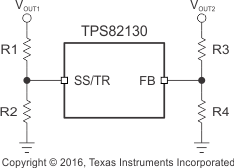SLVSCY5F February 2016 – January 2023 TPS82130
PRODUCTION DATA
- 1 Features
- 2 Applications
- 3 Description
- 4 Revision History
- 5 Pin Configuration and Functions
- 6 Specifications
- 7 Detailed Description
- 8 Application and Implementation
- 9 Device and Documentation Support
- 10Mechanical, Packaging, and Orderable Information
Package Options
Mechanical Data (Package|Pins)
- SIL|8
Thermal pad, mechanical data (Package|Pins)
Orderable Information
7.4.3 Voltage Tracking (SS/TR)
The SS/TR pin is externally driven by another voltage source to achieve output voltage tracking. The application circuit is shown in Figure 7-1.
 Figure 7-1 Output Voltage Tracking
Figure 7-1 Output Voltage TrackingWhen the SS/TR pin voltage is between 50 mV and 1.2 V, the VOUT2 tracks the VOUT1 as described in Equation 5.

When the SS/TR pin voltage is above 1.2 V, the voltage tracking is disabled and the FB pin voltage is regulated at 0.8 V. To decrease the SS/TR pin voltage, the device does not sink current from the output, so the resulting decreases of the output voltage can be slower than the SS/TR pin voltage if the load is light. When driving the SS/TR pin with an external voltage, do not exceed the voltage rating of the SS/TR pin which is VIN + 0.3 V.
Details about tracking and sequencing circuits are found in the Sequencing and Tracking With the TPS621-Family and TPS821-Family Application Report.